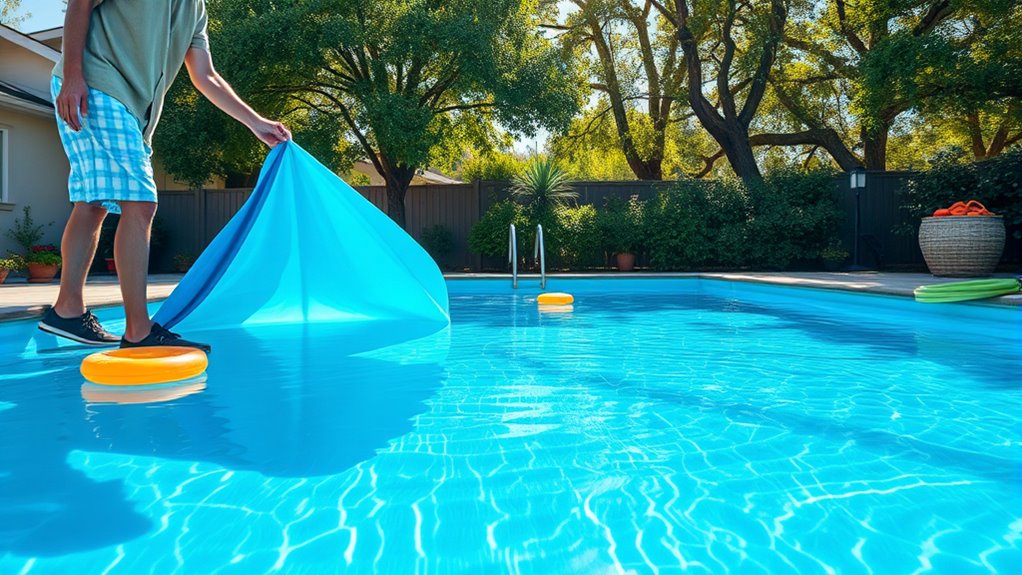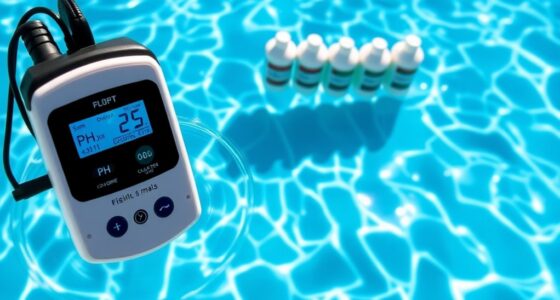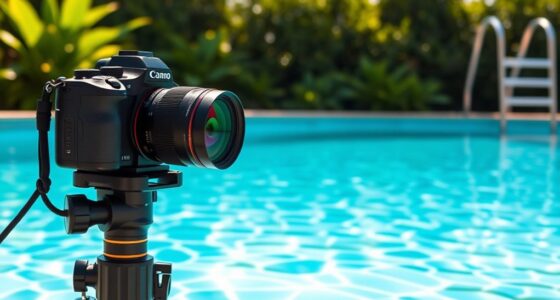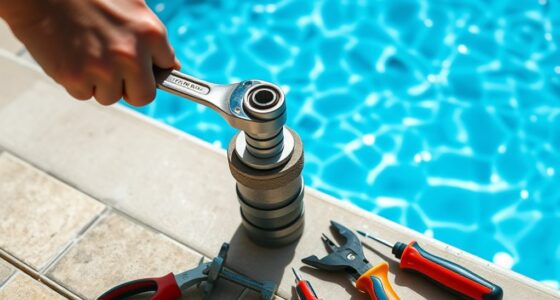To open your pool for summer, start by gathering all your supplies and carefully removing and cleaning your cover. Inspect and repair your equipment, then fill your pool to the proper level, guaranteeing good water circulation. Reconnect your filtration system, shock the water to kill bacteria and algae, and run the pump to circulate chemicals. Finish by cleaning surfaces and doing safety checks. Continue with these steps to ensure a safe, clean start to your swimming season.
Key Takeaways
- Remove and clean the pool cover, ensuring it’s dry before storage to prevent damage and debris buildup.
- Inspect and repair pool equipment like the pump, filter, and heater to ensure proper functionality.
- Refill the pool to the recommended water level, usually at the skimmer opening’s midline, and check for leaks.
- Test water chemistry regularly and adjust pH, chlorine, alkalinity, and stabilizer levels for optimal balance.
- Run the pump and filter, clean surfaces, and perform safety checks on fencing, gates, and safety equipment.
Gather Your Pool Opening Supplies
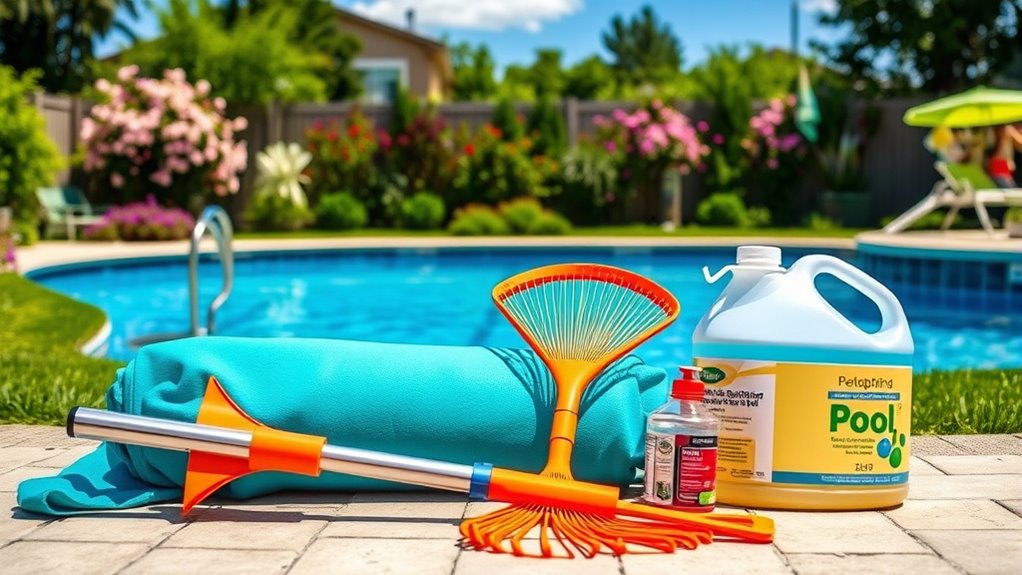
Before you start opening your pool, it’s essential to gather all the necessary supplies. Begin with pool cover removal tools—these will help you lift and remove the cover safely without damage. Next, gather your cleaning supplies, including a pool skimmer, brushes, and a pool vacuum if needed. You’ll also want a hose for rinsing and a bucket for debris. Don’t forget to have a pool test kit on hand to check water chemistry later. Make sure you have gloves and safety goggles for protection. Organizing everything beforehand so you’re ready to work efficiently is crucial. Proper preparation sets a solid foundation for a successful pool opening. Additionally, reviewing safety precautions can prevent accidents during the process. Staying informed about AI security measures can also help protect your data and devices while managing your pool equipment and smart features. It’s also helpful to familiarize yourself with pool chemistry basics to ensure proper water balance from the start. Being aware of symptoms of pool issues can help you identify problems early and address them promptly. Incorporating adventurous spirit into your approach can make the process more engaging and rewarding.
Remove and Clean the Pool Cover
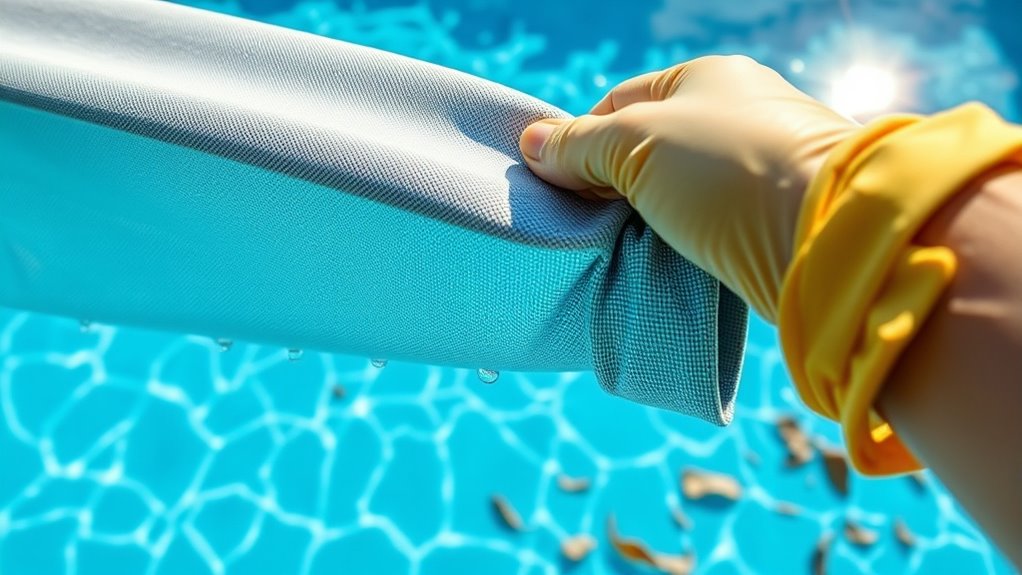
Start by carefully removing the pool cover, using your cover removal tools to lift it without causing damage. During winterization removal, debris can accumulate on the cover, so clear off loose leaves, twigs, and dirt as you go. Gently fold or roll the cover to prevent debris from falling into the pool once removed. Inspect the cover for tears or damage and clean it thoroughly with a garden hose, using a mild soap if necessary. This step helps prevent debris from entering the pool, reducing potential clogging and staining. Proper removal and cleaning now save you time later and keep debris prevention a priority for a smooth opening. Additionally, ensuring the cover is free of tears can help avoid equipment malfunctions during the pool opening process. Make sure the cover is completely dry before storing it in a cool, dry place. Being aware of regional weather patterns can also help you plan the best time for cover removal and storage. Incorporating proper storage techniques can further prolong the lifespan of your pool cover and maintain its effectiveness for future seasons.
Inspect and Repair Pool Equipment
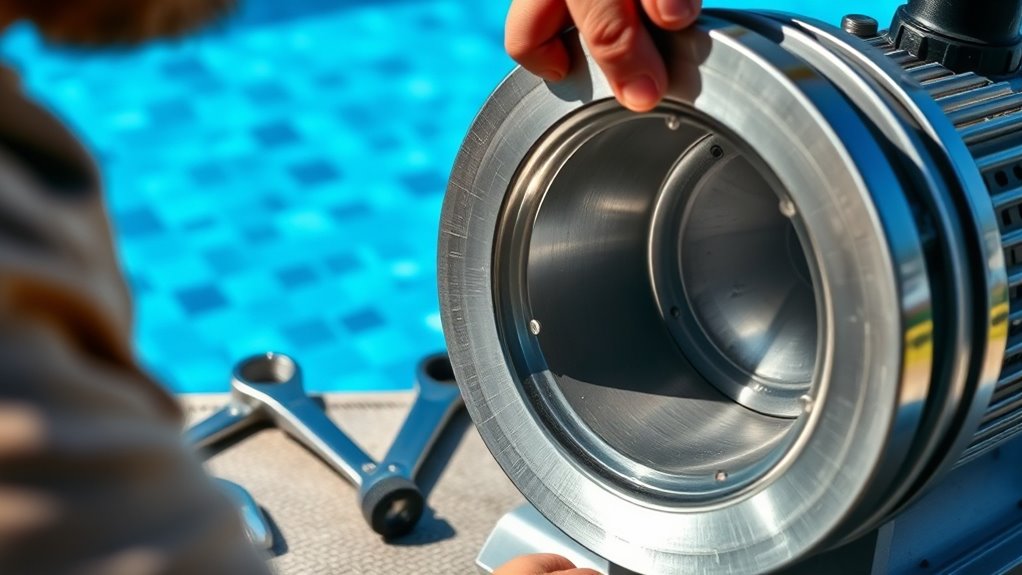
Inspecting and repairing your pool equipment is essential to guarantee everything operates smoothly throughout the season. Start by checking your pool heater to ensure it heats efficiently and shows no signs of leaks or corrosion. If you notice issues, repair or replace faulty parts before using it regularly. Next, inspect your chlorinator and perform chlorinator maintenance by cleaning or replacing cells to ensure proper chlorine distribution. Examine the pool pump and filter for debris or wear, and clear out any blockages to maintain ideal water flow. Tighten loose fittings and replace damaged hoses or seals. This proactive maintenance prevents breakdowns and keeps your pool safe and clean all summer long. Properly functioning equipment makes your swimming experience more enjoyable and reduces costly repairs later. Additionally, utilizing automation technology can help monitor and manage your pool’s systems efficiently through automated insights, ensuring optimal operation without constant manual checks. Regular inspections can also help identify hidden issues early, preventing costly repairs down the line. Incorporating advanced diagnostics can further enhance your ability to detect potential problems before they escalate.
Fill the Pool to the Proper Level
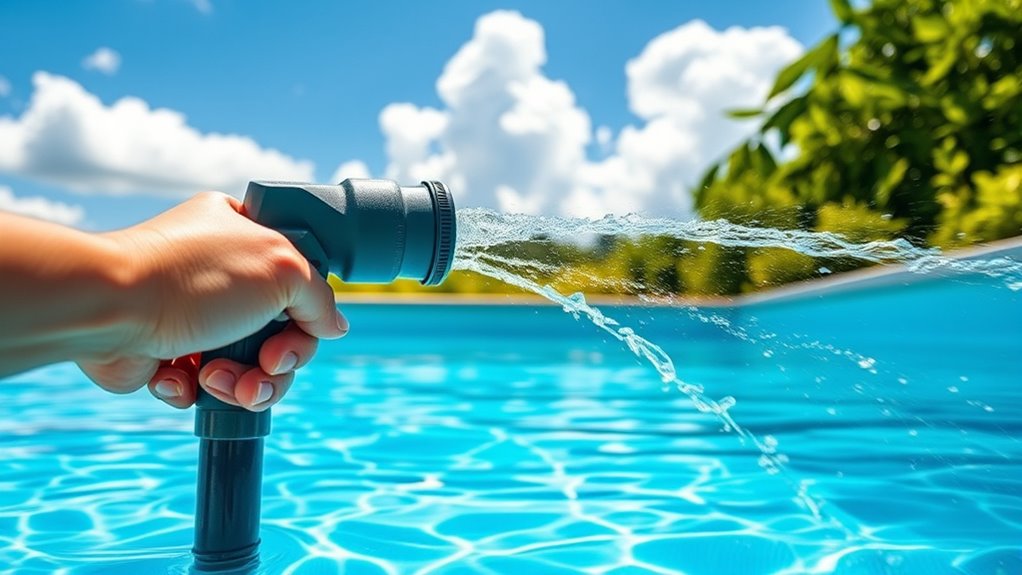
Filling your pool to the correct level is essential for ideal operation and water balance. The right water level guarantees your skimming techniques work effectively and prevents damage to the pool’s filtration system. To achieve this, follow these steps:
- Use a hose or a submersible pump to add water gradually.
- Check the water level against the pool’s skimmer opening, aiming for it to be at the midline.
- Adjust the water as needed to maintain a consistent level, especially after evaporation or splashing. Proper water levels also help prevent filter damage, which can be costly to repair.
- Monitor the water level regularly during filling to avoid overfilling or underfilling.
- Ensuring proper water levels also supports the overall water chemistry balance and prevents issues with algae or bacteria growth. Regularly inspecting and maintaining your pool’s filtration system can enhance its longevity and performance.
- Maintaining optimal water levels can also improve the efficiency of pool cleaning systems. Consistent water levels help maintain proper chemical balance, which is crucial for safe swimming conditions.
Keeping the water at the proper level not only improves skimming efficiency but also helps balance chemicals and keeps your pool running smoothly all season.
Reconnect and Check Pool Filtration System
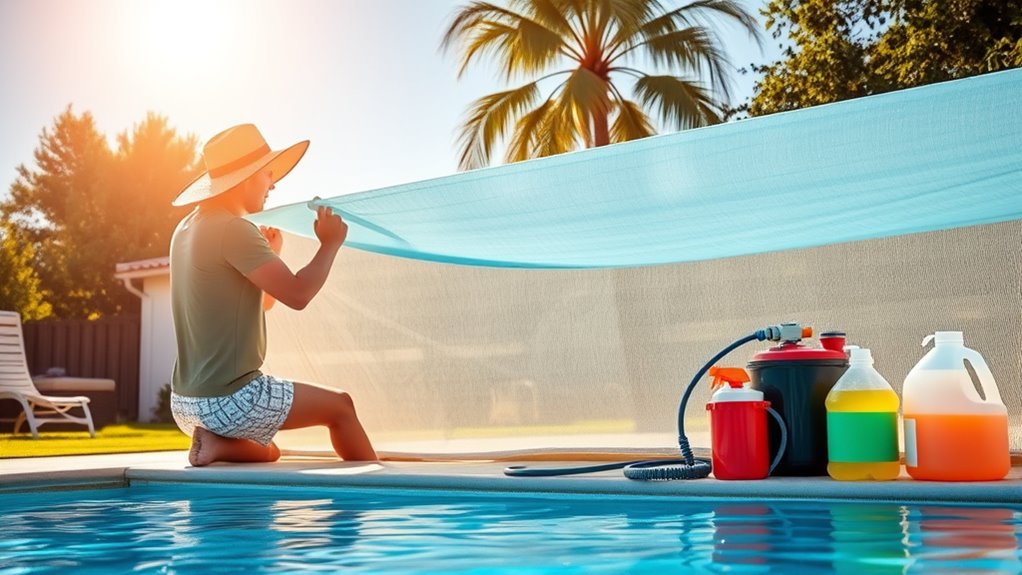
Before running your pool for the season, it’s important to reconnect and thoroughly check your filtration system to make certain it operates efficiently. Start by inspecting all hoses and fittings for leaks or cracks, ensuring proper pool circulation. Reconnect the pump and filter, making sure they’re securely attached. Check the filter for debris or buildup, and perform any necessary filter maintenance, such as cleaning or replacing cartridges. Turn on the system and listen for unusual noises that could indicate issues. Observe the water flow to confirm the filter is working correctly. A well-maintained filtration system keeps water clear and healthy, preventing algae and debris buildup. Proper reconnection and filter checks are essential steps to ensure your pool’s circulation runs smoothly all season long. Regular maintenance of your filtering system can help extend its lifespan and improve overall pool performance. Additionally, inspecting the crochet or knitting accessories used in maintenance tasks can help prevent accidental damage during handling. Being aware of state tax implications for IRA withdrawals can also influence your overall financial planning during retirement. To further ensure optimal function, consider reviewing the performance upgrades of your filtration components, which can sometimes enhance efficiency and longevity.
Balance Pool Water Chemistry
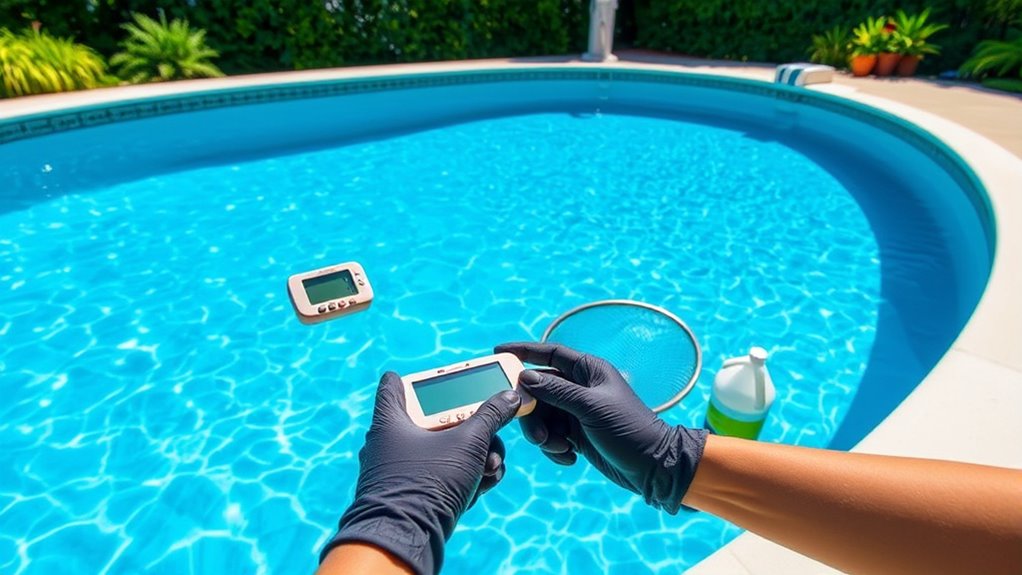
To maintain your pool safe and inviting, you need to regularly test the water. If the pH levels are off, adjust them with the right chemicals to prevent issues. Staying on top of these steps ensures your pool stays balanced all summer long. Additionally, using proper filtration systems can help improve indoor air quality if your pool area is enclosed. Regular maintenance of your filter is essential to keep the water clean and clear throughout the season, and choosing the right air purifier can further enhance the environment around your pool area. Incorporating advanced air purification technology, such as HEPA filters and activated carbon, can help eliminate odors and airborne pollutants effectively. Moreover, some celebrity lifestyles include designing private paradises that serve as personal retreats, inspiring homeowners to create their own oasis.
Test Water Regularly
Regularly testing your pool water is essential to maintaining a healthy and inviting swimming environment. Water testing helps you monitor chemical levels and guarantee proper chemical balancing, preventing issues like cloudy water or algae growth. To keep your water in check, consider these steps:
- Use a reliable test kit or strips to check pH, chlorine, alkalinity, and stabilizer levels.
- Record test results to track changes over time.
- Adjust chemicals promptly if levels are outside recommended ranges.
- Repeat testing at least twice a week during peak season to maintain ideal water quality.
- Ensuring your filter and equipment are functioning properly can also enhance water clarity and quality, as proper maintenance plays a crucial role in air purification for your pool environment.
- Being aware of the power consumption of your pool equipment can help you manage energy costs and ensure safe operation, especially for electric components and pumps.
Consistent water testing allows you to catch imbalances early, ensuring your pool remains clean, safe, and enjoyable all summer long. Proper chemical balancing is key to a sparkling, healthy pool.
Adjust Ph Levels
Ensuring your pool water has the correct pH level is essential for maintaining a balanced and safe swimming environment. Proper pH adjustment prevents irritation, equipment damage, and algae growth. To achieve chemical balancing, test your water regularly and adjust the pH accordingly. If the pH is too low (below 7.2), add pH increaser; if it’s too high (above 7.8), use pH reducer. Use the following guide for reference:
| pH Level | Action | Tips |
|---|---|---|
| Below 7.2 | Add pH increaser | Repeat testing after adjustment |
| 7.2-7.8 | Ideal range | Maintain regularly |
| Above 7.8 | Add pH reducer | Avoid overcorrection |
| 7.0-7.2 | Slightly acidic | Adjust carefully |
| 7.8-8.0 | Slightly alkaline | Balance with care |
Consistent pH adjustment guarantees safe, clear water for summer fun.
Add Proper Chemicals
After adjusting your pH levels, the next step is adding the proper chemicals to balance your pool water chemistry. Ensuring pool chemical safety is vital—always follow manufacturer instructions and wear protective gear. Proper chemical storage prevents accidents and keeps your chemicals effective. To balance your water, consider these steps:
- Test the water with a reliable kit to determine needed chemicals.
- Add chlorine or a sanitizer to disinfect the water.
- Adjust alkalinity and calcium hardness to prevent scale and corrosion.
- Shock the pool if necessary to eliminate bacteria and algae.
Always handle chemicals carefully, adding them gradually and never mixing different chemicals directly. Proper chemical storage and following safety guidelines ensure a safe and effective pool opening.
Shock the Pool to Kill Bacteria and Algae
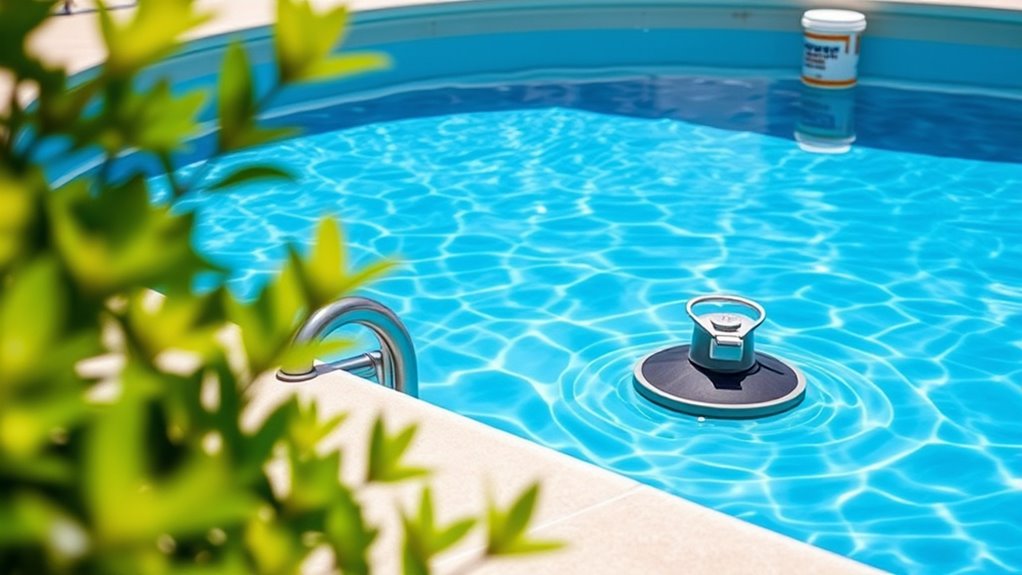
To effectively eliminate bacteria and algae, you need to shock your pool with a high dose of chlorine or a pool sanitizer. Shocking triggers bacteria removal and destroys algae that may be starting to grow. Start by testing your water’s current chlorine levels to determine the right amount of shock treatment needed. Use a pool shock product, following the manufacturer’s instructions carefully. Pour the shock evenly around the pool, focusing on areas with visible algae or debris. Allow the chemicals to circulate for at least 8-12 hours before swimming. Shocking not only kills bacteria but also clears cloudy water and prevents algae from taking hold. Remember, consistent shocking during opening helps maintain a clean, safe swimming environment all season long.
Run the Pump and Filter System
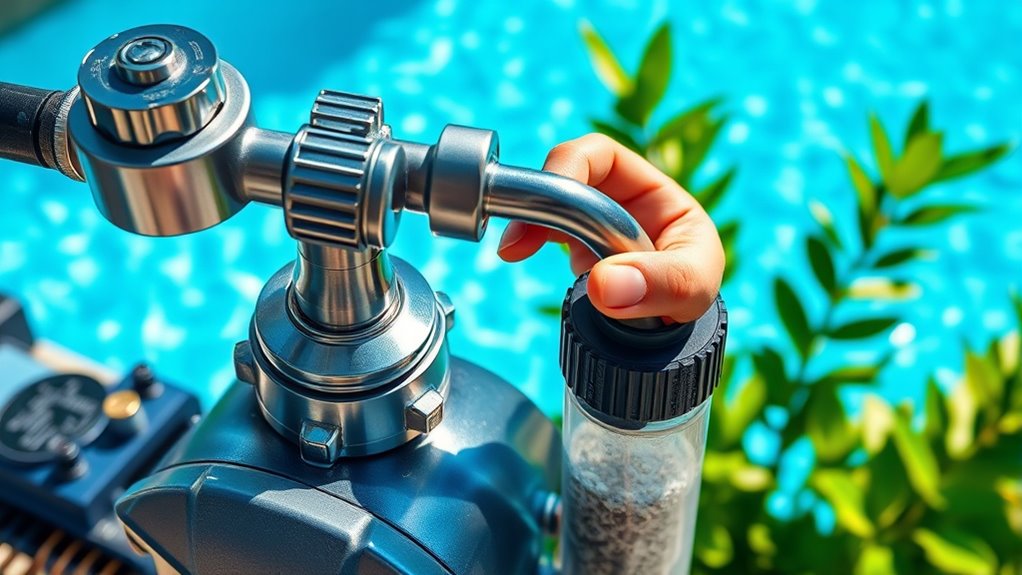
Have you turned on your pool’s pump and filter system yet? Running your pump ensures proper circulation and helps keep the water clean. First, check that all connections are secure and the system is free of leaks. Next, set the timer to operate at peak hours for ideal filtration. Then, monitor the pump for unusual noises or vibrations—these could indicate pump maintenance issues. Finally, inspect the filter for clogging or debris, performing filter troubleshooting if water flow seems weak. Regularly running your pump and maintaining the filter prevents algae buildup and keeps your water sparkling. Remember, a well-maintained system is key to a beautiful, safe swimming pool all summer long.
Clean the Pool Surfaces and Skim Debris
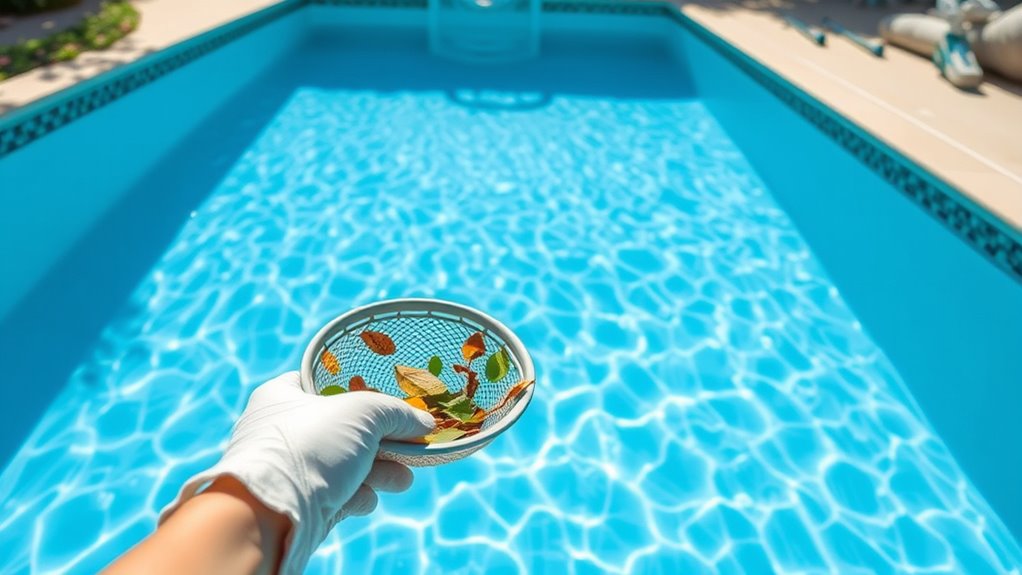
Cleaning the pool surfaces and skimming debris are essential steps to keep your water clear and inviting. Start by inspecting the pool walls, floor, and steps for dirt, algae, or buildup. Use a pool brush or scrubbing pad to thoroughly clean these surfaces, removing any algae or grime that may have accumulated over the off-season. Next, skim the water’s surface with a net to remove leaves, insects, and floating debris. Regular debris removal prevents clogging of your skimmer and filter, ensuring peak circulation. Be diligent and thorough—this step helps maintain water clarity and prevents staining or algae growth. Once complete, your pool will be ready for the next phase of opening, with clean surfaces and debris-free water.
Final Inspection and Safety Checks
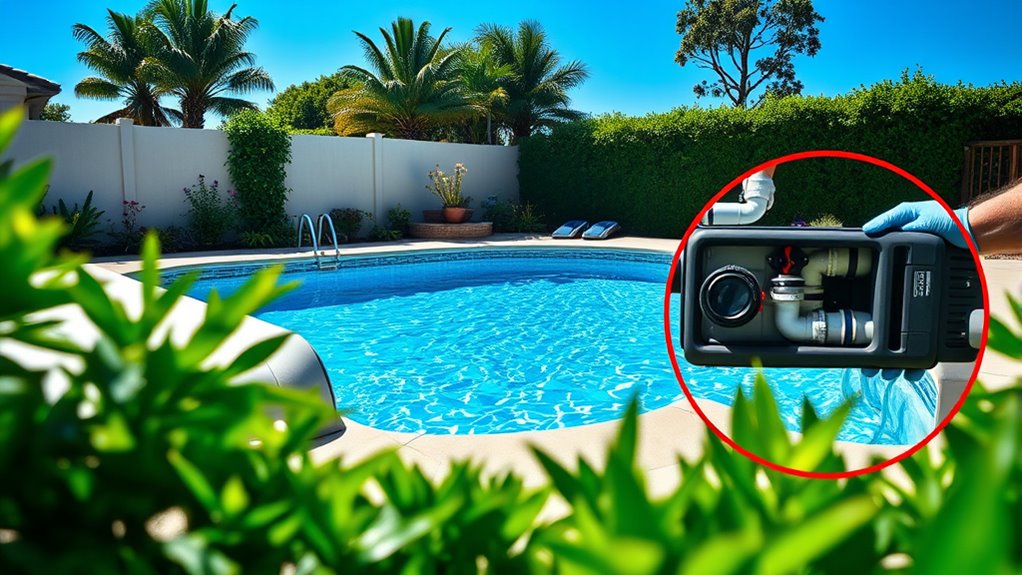
Before filling your pool with water, perform a thorough final inspection and safety check to guarantee everything is in proper working order. This step ensures your pool safety and prevents accidents. Use an inspection checklist to verify key components.
- Check all pool fencing and gates to ensure they lock securely.
- Inspect the pool pump, filter, and skimmer for proper operation.
- Examine ladders, handrails, and diving boards for stability and damage.
- Test your pool’s safety equipment, like life rings and alarms.
Completing this safety check minimizes hazards and confirms your pool is ready for summer fun. Taking the time for a detailed inspection helps you enjoy a safe, trouble-free season.
Frequently Asked Questions
When Is the Best Time to Open My Pool for Summer?
You should open your pool when outdoor temperatures consistently stay above 70°F, signaling it’s time for pool cover removal. This guarantees the water warms up naturally and helps prevent algae growth. Wait until the weather forecast predicts stable warm days to avoid premature opening. Opening at the right time makes pool maintenance easier and extends your swimming season, so keep an eye on the weather and temperature trends before diving in.
How Do I Prevent Algae Growth After Opening the Pool?
To prevent algae growth after opening your pool, you should focus on algae prevention strategies. Start by testing your water and adjusting the pH levels. Then, perform a chlorine shock to kill any existing algae spores and boost your sanitizer’s effectiveness. Regularly brush the pool walls and use algaecide as needed. Consistent maintenance and proper chemical balance will keep algae at bay and ensure your pool stays crystal clear all summer.
What Safety Precautions Should I Take During Pool Opening?
When opening your pool, make sure to prioritize pool safety by inspecting all pool equipment for damage or wear before use. Always wear protective gear like gloves and goggles when handling chemicals or cleaning. Keep a first aid kit nearby, and guarantee children or pets are supervised around the water. Properly secure pool covers and fences to prevent accidents. These safety precautions help you enjoy a safe and fun swimming season.
How Often Should I Check Water Chemistry During Summer?
Did you know that bacteria can double in number every 20 minutes if water chemistry isn’t balanced? During summer, you should check your pool water testing at least two to three times a week. Regularly monitoring your pool chemistry helps prevent algae growth, cloudy water, and swimmer discomfort. Staying on top of water testing guarantees your pool stays safe, clean, and inviting all season long.
How Do I Winterize My Pool After the Season Ends?
To winterize your pool, start with essential winterization tips like balancing the water chemistry and lowering the water level. Next, drain equipment and add winterizing chemicals. Remove the pool cover carefully, making sure to clean it thoroughly before storage. Store your pool accessories in a dry, protected area. Following these steps helps prevent damage and makes spring opening easier, ensuring your pool stays in great shape during the off-season.
Conclusion
Think of opening your pool as awakening a dormant garden—careful tending brings it back to life. As you follow each step, you’re nurturing a crystal-clear oasis ready for summer’s joys. With patience and attention, your pool will flourish, inviting you to plunge into invigorating relaxation. Embrace this process like tending a treasured garden, and you’ll enjoy a vibrant, inviting sanctuary all season long.

